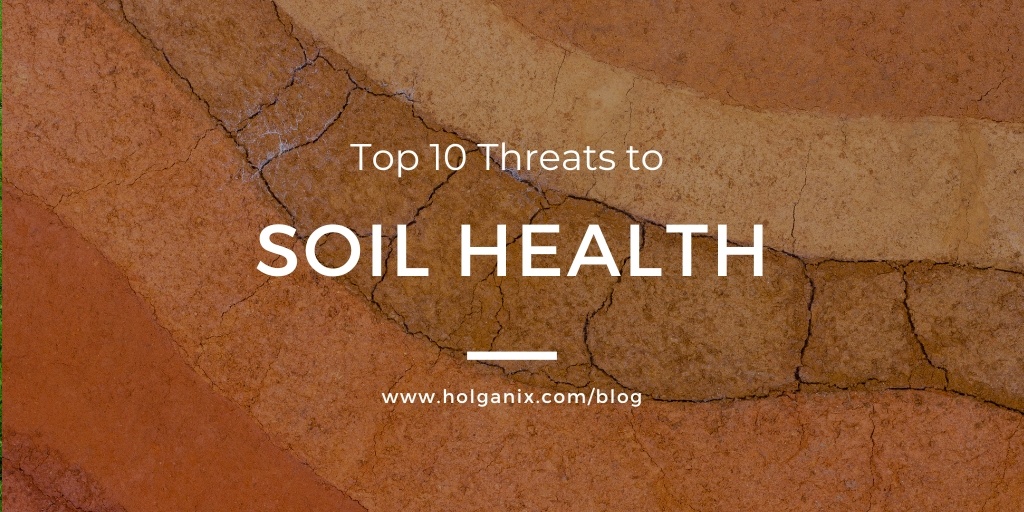.jpg?width=1024&height=512&name=blog%20header%20(32).jpg)
From building soil health to protecting your fertilizer investment, there are lots of reasons to leave residue on your fields. But, too much residue can also cause problems. Farm equipment can jam seed, placement can be affected and the soil may warm more slowly, impacting emergence.
"Uneven emergence of your crop can cost you in yield at the end of the season," explains David Stark Ph.D., President of Agriculture at Holganix LLC. “What we want is to be able to keep residue on the field, but to control it, and not have it cause any problems come spring.”
The decomposition of crop residues on the farm is influenced by a variety of factors, both environmental and management related. These factors can affect the rate and efficiency of decomposition, which in turn can impact soil health, nutrient cycling, and overall agricultural sustainability.
Keep reading to discover:
10 Factors that Contribute to the Decomposition of Crop Residue
- Crop Residue Composition: The chemical composition of the crop residue itself plays a significant role. Residues high in lignin, and other complex organic compounds, tend to decompose more slowly, while those rich in easily degradable materials (such as sugars and proteins) decompose faster.
- Microbial Activity: Microorganisms, including bacteria, fungi, and other decomposers, are responsible for breaking down organic matter, but of these, fungi are by far the best degraders. Soil microbial populations, and their activity levels, influence the rate of decomposition. Factors like moisture, temperature, and nutrient availability affect microbial activity. For residues high in lignin and cellulose, like corn stover and wheat straw, having the right fungi is critical to degradation.
- Moisture: Adequate moisture is essential for microbial activity and enzymatic processes that drive decomposition. Too much moisture can lead to waterlogging and anaerobic conditions, while too little moisture can slow down decomposition.
- Temperature: Decomposition rates increase with higher temperatures within certain ranges. Warmer climates generally promote faster decomposition. However, extreme temperatures, whether too high or too low, can inhibit microbial activity.
- Oxygen Availability: Aerobic decomposition (occurring in the presence of oxygen) is typically more efficient and produces fewer byproducts compared to anaerobic decomposition. Well-drained soils provide better oxygen diffusion, supporting aerobic decomposition.
- Nutrient Availability: Microorganisms require nutrients (carbon, nitrogen, phosphorus, etc.) to carry out decomposition. The carbon-to-nitrogen (C:N) ratio of crop residues is important; a lower C:N ratio tends to accelerate decomposition, as microbes break down the residue to obtain nitrogen.
- Tillage and Incorporation: Practices like tillage and residue incorporation can physically break down and mix crop residues with the soil, increasing their contact with decomposers and enhancing decomposition rates. However, tilling makes the ground more prone to erosion, compaction and decreases fungal populations.
- pH and Soil Chemistry: Soil pH can affect microbial activity and decomposition rates. Certain pH levels may be more conducive to decomposition, depending on the microbes involved.
- Crop Residue Management: Leaving crop residues on the soil surface as mulch can create a protective layer that moderates temperature and moisture, influencing decomposition. Chopping or crushing the residue creates more entry points for microbes and will enhance decomposition.
- Presence of Inhibitors: Some chemicals or compounds in crop residues, such as allelochemicals or pesticides, can inhibit microbial activity and decomposition.
Meet Holganix Bio 800+ Breakdown
Holganix Bio 800+ Breakdown charges soil with a consortium of over 800 species of soil microbes, nitrogen, and microbe food. The microbes have heightened fungal species that play a special role in crop residue breakdown.
What can you expect from Holganix Bio 800+ Breakdown?
- Enhances planter performance
- Breaks down crop residue
- Improves seed emergence
- Releases locked nutrients
- Builds soil health
- Improves emergence and stand establishment with any cover crop planted through residue
Watch this 1-minute clip featuring Barrett Ersek, Holganix CEO & Founder, on why your farm should use Holganix Bio 800+ Breakdown. If you are reading this blog via email, click here to access the video.
Want to Dig In Deeper?
Are you looking to break down crop residue and enhance your fertilizer investment?
Join us in our upcoming webinar on July 23 @ 11:00 AM Eastern, hosted by Holganix CRO, Bryan Hansel to learn more about Holganix Bio 800+ Breakdown product overview and results.
 |
July 18, 2024
|
1:00 PM
|
July 18, 2024
|
1:00 PM
-2.jpg)
-1.jpg)
-1.jpg)
-1.jpg)
.jpg)

-2.jpg)
-1.jpg)
-1.jpg)
-1.jpg)
.jpg)




.jpg?width=1024&height=512&name=blog%20header%20(32).jpg)

.webp)
-1%20(1).webp)
-831535-2.webp)



.jpg)

.jpg)